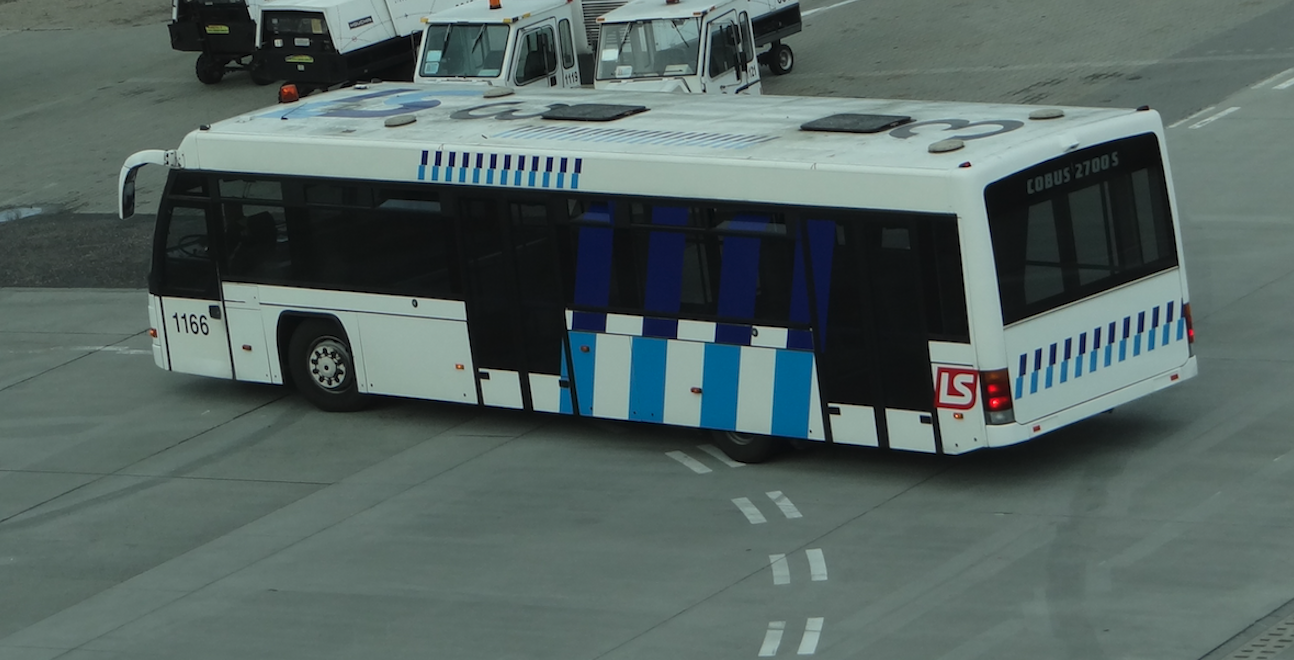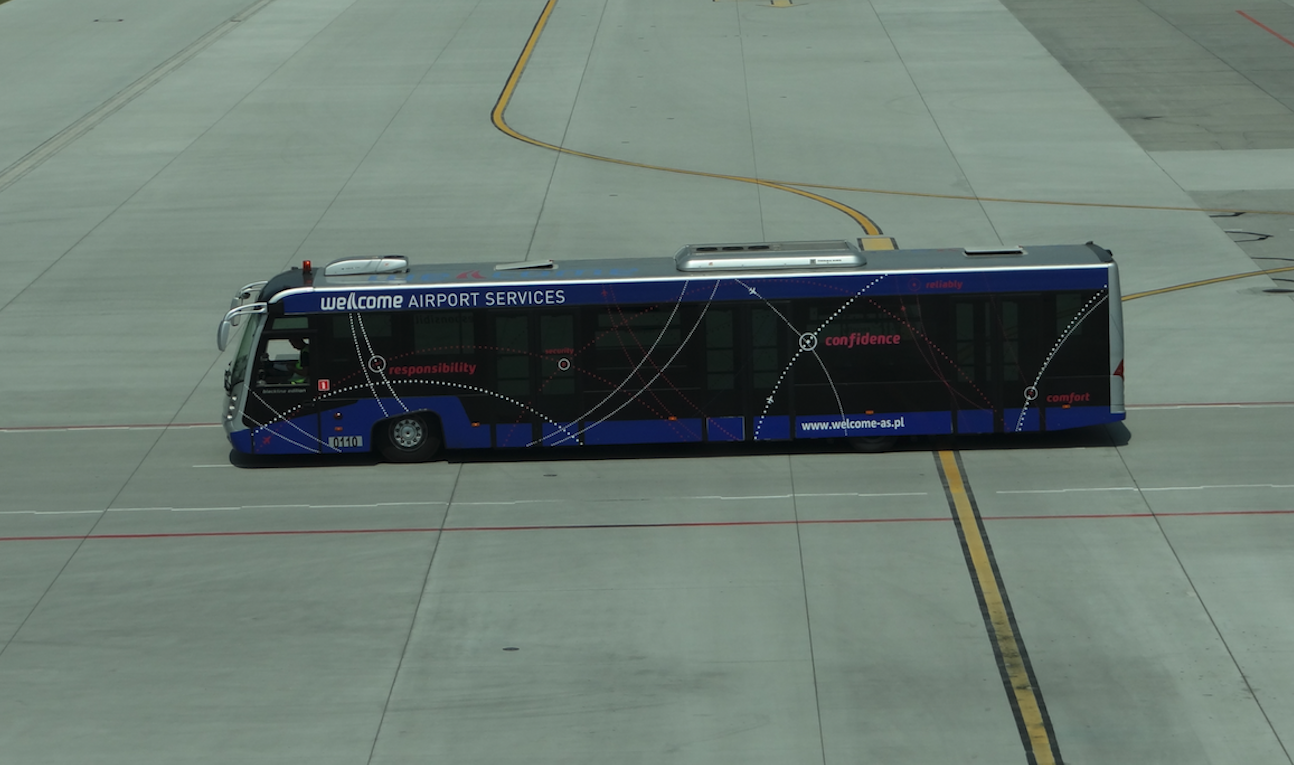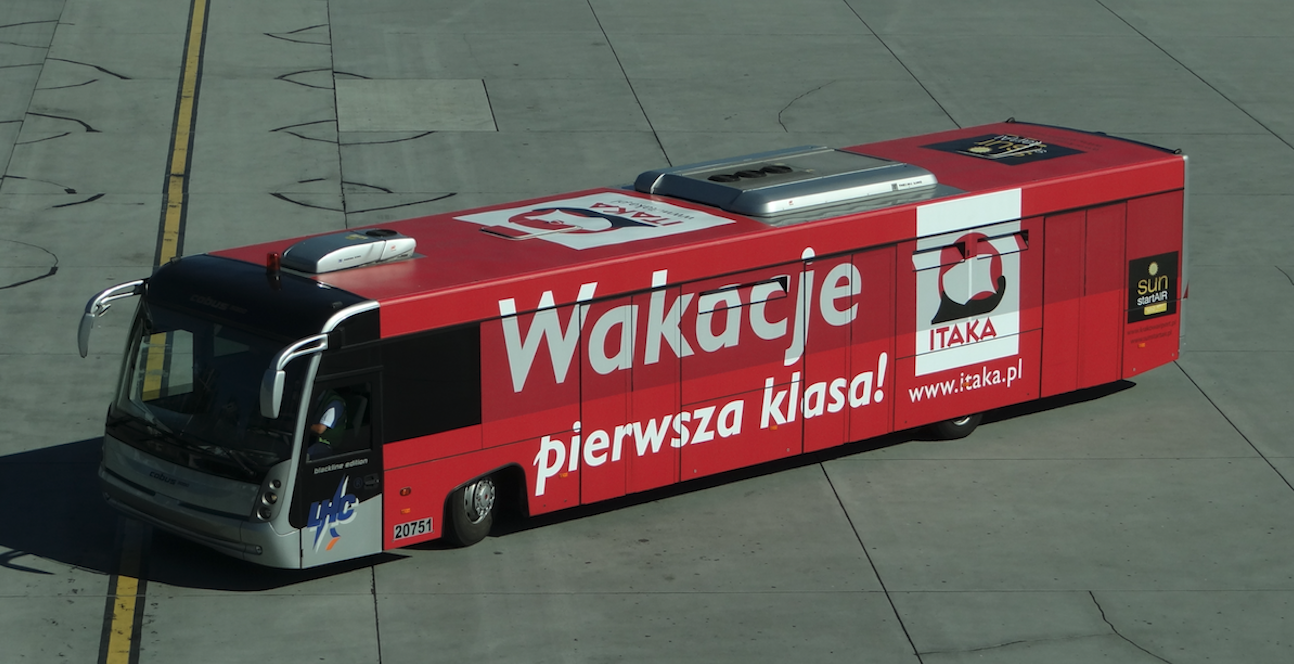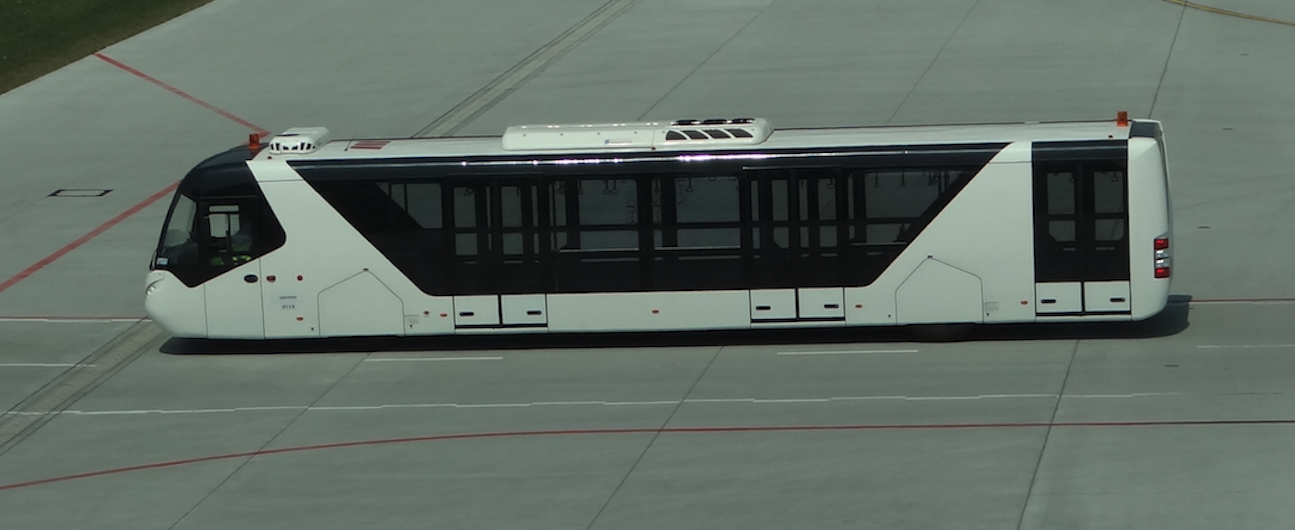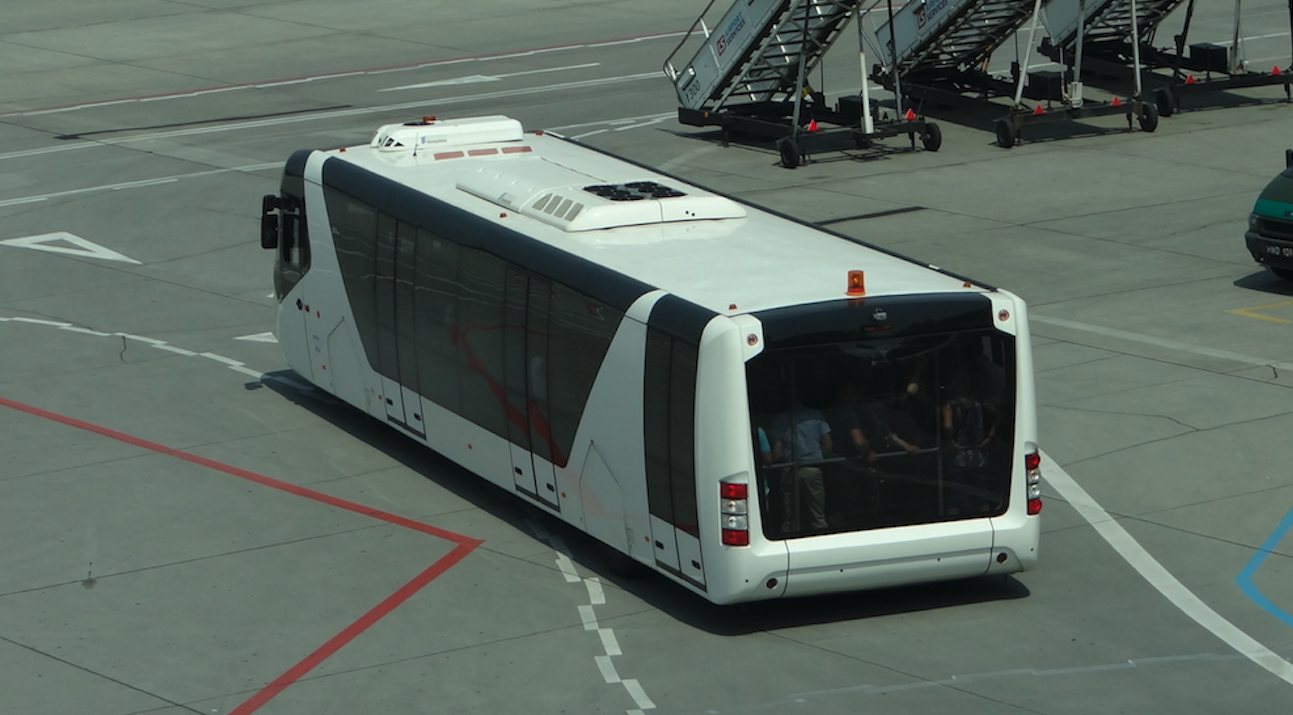Kraków 2018-09-07
Classic platform buses.
Despite its similarity, the platform bus is very different from the city bus. Such a vehicle cannot be registered for road traffic. Platform buses are much wider than city buses. This case is the result of other standards. A city bus can accommodate up to 5 or even 6 passengers per 1 square meter. A platform bus can accommodate up to 4 passengers per square meter. On the other hand, the city bus has higher standards in terms of the number of seats. The platform bus has many more entrance doors. Usually a minimum of three pairs of doors, both port and starboard. In addition, the doors are wider than those in city buses. The door is usually 1.50 m wide. The driver of the platform bus is completely fenced off from passengers. It has its own cab with its own door. Platform buses have lower requirements as to the running gear, especially its suspension.
Platform buses are powered by diesel or gas (LPG or CNG) diesel engines. The power of these engines is around 200 HP, while the motor of a tourist coach often exceeds 400 HP. In a platform bus, the engine is usually located in the front of the vehicle, and in a tourist, intercity or city coach in the back of the vehicle. But more and more platform buses are electric or hybrid driven. The price of one platform bus ranges from PLN 700,000 to PLN 1,000,000 (2018).
CONTRAC / COBUS
The German company CONTRAC is a world leader in the production of airport buses. Full company name Contrac Cobus Industries GmbH. The company was founded in 1978. It has its headquarters and production plant in Wiesbaden. The buses are called COBUS. Therefore, the company changed its name to the more recognizable COBUS Industries GmbH. The Cobus 2400 and Cobus 2700 models (for 99 passengers) were popular, and the Cobus 3000 (for 112 passengers) is currently in production. The offer also includes a fully electric e.COBUS, built on the basis of an aluminum COBUS 3000 box. The electric drive is powered by batteries with a total capacity of 85 kWh LTO (titanium-lithium). Batteries are charged at fixed charging stations. The battery charging time is one to three hours depending on the method of charging.
The standard COBUS 3000 bus has the following dimensions: length 13.92 m, width 3.00 m, height 3.35 m, wheelbase 7.10 m, total turning radius 14.00 m. It is powered by a turbo-supercharged diesel engine. It takes 112 passengers (14 seats), i.e. two COBUS 3000 buses serve one Boeing B.737 plane. It is not without significance that COBUS buses are repaired in Poland by Serwis Auto Matunin in Jelcz-Laskowice. The Polish company has established permanent cooperation with a Germanic manufacturer for servicing and general repairs of these buses. Currently, Cobus is a world leader in the production of platform buses. However, Chinese companies are rapidly approaching the Cobus.
Neoplan
NEOPLAN is one of the leading producers of platform buses. The company has extensive experience in production, gained over almost 65 years. NEOPLAN platform buses run in 160 airports in 75 countries around the world. The first buses of this type left the NEOPLAN factory in 1953. The company currently produces and sells 60-80 buses a year. NEOPLAN buses were manufactured under license in the USA, Australia, Japan, India and China. Initially, the company was called Gottiob Auwarter GmbH & Co, but the success of the NEOPLAN bus family resulted in a name change. The main production facility is in Stuttgart.
In 1975, the company began to produce N9xx series platform buses. There were then three basic varieties: N912 for 65 people (4 people / m2) with 5 seats, dimensions: length 12.26 m, width 2.50 m, height 2.81 m. The second bus N922 is much wider, because it has a width of 3 , 15 m, with the same length and height. Takes 84 passengers. The third bus N940 is much wider (3.75 m) and longer (12.66 m). Takes 100 passengers.
In the new century, NEOPLAN produces new modern platform buses. Airport buses of the N9xxx series are driven by a front, 6-cylinder MAN engine equipped with a common-rail injection system, supercharged by a belt transmission, developing 177 kW (240 HP). Automatic gearbox. The body of the Neoplan bus is made of aluminum. The bus is low-floor and the engine is located in the front of the vehicle. The bus is heated and air-conditioned as standard.
Neoplan airport buses are currently produced exclusively by NEOPLAN partner, the Slovenian company Tovarna Vozil Maribor (TVM), according to the production and quality standards of the Neoplan VIP-Class. In total, the N9xxx family comprises five different models.
The basic model is the Neoplan N9122L. The Neoplan N9122L is the largest vehicle from the Neoplan aviation offer, therefore it is ideal for efficient passenger service of the largest aircraft, such as Boeing B.747 or Airbus A.380. Dimensions 14.72 m long, 3.17 m wide, 3.00 m high with air conditioning in the roof. MAN D0836 LOH52 Euro 4 engine, max power 177 kW (240 HP) at 2300 rpm, capacity 6 . 9 liters. The MAN 0836D LOH Euro 5/6 engine with 220 HP (156 kW) is also installed. Gearbox Voith D851.3E, automatic, 3-speed. Two-axis construction. Kneeling air suspension to lower the floor. The vehicle takes 137-142 passengers. There are only 6 seats inside. Neoplan built a series of buses with a capacity of 200 passengers for the port of Shanghai.
Currently (2017), the offer of Neoplan includes 5 models with a capacity of 66 to a maximum of 142 passengers. The shortest platform bus is 12.00 m long, and the longest 14.72 m. Standard widths are 2.75 and 3.17 m.
Graf & Stift – Austria.
The company was founded in 1901 and produced passenger cars, trucks, and after the Second World War, also buses. From the 1950s, she specialized in the construction of platform buses. In 1980 it was absorbed by the MAN concern.
In the 1970s, it produced several varieties of airport buses with a capacity of 132 to 180 passengers (with 6 people per square meter). The largest was 14.00 m long and had two driver’s cabins, front and rear. The bus has five doors 1.50 m wide. Two pairs of doors are on the side panels and one is at the rear of the vehicle. The bus is low-floor, only 29 cm. Speed up to 50 km / h. The price of the bus in 1979 was $ 230,000.
In the second half of the 1980s, Graf & Stift developed another platform bus. This time it had eight doors; three in the side panels and one pair of doors at the beginning and end of the vehicle. In the course of production, two driver’s cabins were abandoned.
TAM – Yugoslavia / Slovenia.
The first TAM trucks were made at the Maribor factory in 1947. During the socialist period, mainly TAM tourist buses were imported to Poland. Currently, the manufacturer has focused on the production of city and tourist buses as well as buses for airports. For years TAM has been producing airport buses under the Neoplan license. Recently, it offers them under its own brand and the name VivAir. TAM produces about 50-80 airport buses annually, which can already be found at over a hundred airports in the world.
Currently, the TAM VivAir platform bus range includes five models and a VIP version. Customers can choose from a wide range of options tailored to IATA requirements and local airport security standards.
The largest model is the TAM VIVAIR 104 WL. The bus takes 104 passengers with the load of 4 people per square meter, or 130 with the load of 5 people per square meter. The bus is 14.70 m long, 3.18 m wide, 3.02 m high. Diesel engine MAN D0836 LOH 41, 176kW. Automatic gearbox ZF Ecomat 5HP 504C or Voith Diva 3. Doors 4 or 6 double hydraulic tilting (2/3 on each side). Rear doors are offered as an option.
Van Hool – Belgium.
The Van Hool company is a Belgian company that has been on the platform bus market for 80 years. In 2012, the company received an order and started production of its newest platform bus, Van Hool AP2375. The bus is 48 ft (14.64 m) long and 12.5 ft (3.75 m) wide. The bus takes 160 passengers on board at a rate of 4 people per square meter. There are 14 seats in the interior. The bus has six doors; two pairs in each side, front and rear. The vehicle has double air conditioning. Separately for passengers, separately for the driver. The bus is dedicated to the service of Airbus A.380 aircraft. The first order came from Algeria where 17 Van Hool AP2375 buses were delivered.
Xinfa – Aero ABus – China.
Gone are the days when China was ineptly trying to copy Western buses. Currently (2017), China is the world’s largest producer of platform buses, with three large factories. Their platform buses have yet to reach European and US airports, but it’s only a matter of time.
Xinfa / Aero ABus is a well-known Chinese company that produces platform buses. Xinfa Airport Equipment Ltd. Abbreviation "Xinfa", founded in 1997. Initially owned by Beijing BOWEI airport facilities management Co. Ltd. (a subsidiary of Beijing Capital International Airport Group Co.). On January 4, 2012, Shenzhen CIMC-Tianda Airport Support Ltd. (CIMC Group Airport) officially became the company’s largest shareholder, acquiring 70% of the shares. The share capital of Xinfa has been increased to 25 million RMB. Aero ABus is a trademark.
Xinfa is the second largest producer of platform buses in the world. Only Cobus is ahead of it. In 2010, Xinfa overtook Neoplan.
By 2015, Xinfa had built over 550 platform buses. It has 70% of the market in China. Its buses are in 25 countries at 80 airports. Aero ABus platform buses have proven to be reliable and durable. The first copies are already 20 years old and are still in use today.
One of the most famous designs is the Aero ABus-6300. The model has been in production since 1997. The bus takes 110 passengers on board. It is 13.90 m long, 3.00 m wide and 3.18 m high. The drive is a diesel engine. The bus has four doors, two pairs on each side. The bus body is made of aluminum.
Aero ABus buses are available in smaller versions, taking 77 passengers on board. There are also versions with three pairs of doors and a version with doors at the front and rear of the vehicle.
Youngman – China.
For about twenty years, the Chinese have been developing and building platform buses themselves. The producer is, among others, Youngman. The Chinese are following the platform buses of Neoplan and Cobus, which were produced at home many years ago. The Youngman JNP6140 platform bus has been in production since 2008. The appearance is similar to the newest Neoplan buses. Some say it is a copy of the Neoplan N9122 bus. The Chinese do not pay much attention to the strict European emission standards and in their buses they install engines that meet Euro 3 standards, instead of the Euro 6 standard currently in force in Europe. Thanks to this, the engines they buy are cheaper and more durable. MAN engines are used in the Youngman JNP6140 bus; more powerful DEUTZ BF6M1013-19EIII with 240 HP (190 kW) and weaker DEUTZ BF4M1013-9E3 with 190 HP (140 kW). Allison T270R automatic gearbox. The maximum speed of the vehicle is 62 km / h.
Youngman JNP6140 is low-floor and has the following dimensions: length 14.00 m, width 3.17 m, height 3.00 m, wheelbase 7.28 m, turning radius 14 m. The bus takes 145 passengers. It has six doors; three on each side.
It is estimated that approximately 300-400 Youngman JNP6140 buses have been built and are in use in China and other Asian countries.
King Long – China.
King Long is also a Chinese company that builds platform, low-floor, wide buses. A popular model is the King Long XMQ6139B, which was developed in 2007. It is modeled on the Cobus and Neoplan constructions, but it is undoubtedly not confusingly similar to them. You can see the work of Chinese stylists here. The bus takes up to 150 passengers on board. It has a 220 hp (162 kW) diesel engine that meets Euro 4 emission standards. Automatic gearbox. Develops a speed of up to 50 km / h. King Long XMQ6139B has dimensions; Length 13.83 m, width 3.00 m, height 3.20 m, wheelbase 7.00, turning radius 14.00 m.
King Long coaches and minibuses are used, among others, in the UK and Ukraine.
MAZ – Belarus.
The MAZ factory was established in Minsk in CCCP (now Belarus) in 1944 and was engaged in the production of trucks and specialized chassis for the army. In the 1950s, it began producing buses. In 2005, on the orders of the Belarusian authorities, the factory entered the market with platform buses. The first was the MAZ-171 model. The bus went to airports in Belarus, Russia, Azerbaijan and other Asian countries. The bus is not popular in Europe due to the lack of engines that meet the latest emission standards (Euro 6). The situation has changed since 2015.
MAZ-171 buses were and are produced in several varieties. Standard one takes 122 passengers on board. There are six seats in the interior. The drive is powered by a 170 HP (125 kW) DEUTZ BF4M1013-FC engine, which meets the Euro 3 exhaust emission standards. Automatic gearbox.
MAZ-171 buses is low-floor and has dimensions; Length 14.40 m, width 3.15 m, height 3.20 m, wheelbase 7.12 m, turning radius 15 m.
Poland
Platform buses in Poland appeared relatively late. The first ones appeared at the Okęcie Airport in 1968, almost in line with the commissioning of the new airport station (terminal). These were SAN buses built at the factory in Sanok.
In the mid-70s, passenger trailers, pulled by STAR 27 trucks, appeared at Okęcie Airport. They were original access vehicles, but more adapted to the specific needs of the airport. Platform buses appeared at other Polish airports only in the first half of the 90s. The first sleeves at Okęcie were built together with a new terminal called beetroot, which was put into use in 1993 due to the color of the roof.
SOLARIS Poland.
It should be mentioned that Poland is currently (2017) the third largest producer of city buses and tourist coaches in the world. Every third bus comes from Poland. There are as many as six bus factories in Poland. Annually, they assemble over 3,700 vehicles.
Since 2004, the Polish company Solaris Bus & Coach from Bolechowo has been one of the producers of platform buses. The Solaris Urbino 10 airport buses have a capacity of 61 passengers. Inside, there are 8 seats, including so-called half-rails, to leave as many standing places as possible. Additionally, several racks for hand luggage were installed. Their driveline uses an IVECO NEF engine with a capacity of 176 kW and a Voith 854.3 automatic gearbox. The bus is air-conditioned in the passenger compartment of the S ü trak company. The bus is 10.00 m long and has a low-floor structure. The great advantage of this bus is the affordable price and high availability of spare parts.
Until now, vehicles with only starboard doors have been built, but Solaris Bus & Coach offers versions with doors on both sides. There are also buses with single wheels on the rear axle, which will give more space in the interior, and weaker engines and 2-speed automatic gearboxes, which is sufficient at the airport. The buses can also be offered in versions with a body length of 12 and 14 meters. There are also plans for buses with electric drive.
At the present stage of the company’s activity, there are no plans to build bus boxes over 3 m wide.
Written by Karol Placha Hetman

